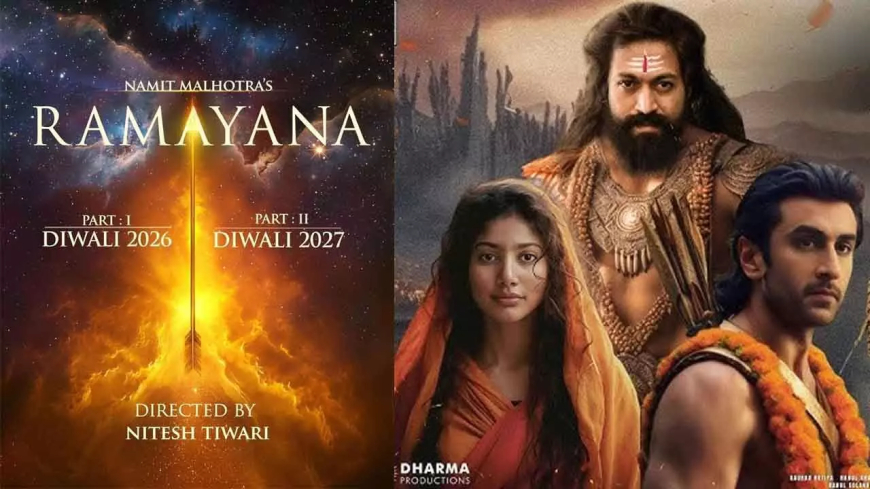Ramayana Sets New Benchmark: India’s First ₹4,000 Crore Film Redefines Cinematic Ambition
Ranbir Kapoor's Ramayana, produced by Namit Malhotra, becomes the most expensive Indian film ever made with a ₹4,000 crore budget. Backed by Yash, Sunny Deol, and Amitabh Bachchan, this two-part epic is set to redefine Indian cinema.

Mumbai, July 15, 2025 – In a move that could reshape Indian cinema, producer Namit Malhotra is charging ahead with Ramayana, a two-part epic adaptation with a staggering budget of ₹4,000 crore (approximately USD 500 million). Headlined by Ranbir Kapoor as Lord Ram and supported by a stellar ensemble including Yash, Amitabh Bachchan, Sunny Deol, and Sai Pallavi, this production officially claims the title of the most expensive Indian film ever made.
1. Unprecedented Scale: ₹4,000 Crore Budget
Malhotra confirmed publicly that the combined production budget for Ramayana’s two parts will exceed ₹4,000 crore, overtaking previous megabudgeted projects like Adipurush, RRR, and Kalki 2898 AD Zoom TV+13India Today+13The Times of India+13Wikipedia+3The Financial Express+3The Times of India+3. Earlier estimates had placed the cost at ₹1,600 crore, but this has now been superseded by the final figure .
Crucially, Malhotra and his team are self-funding the entire project without external financing . This underscores both his confidence in the venture and a desire to maintain creative control.
2. Star Power That Matches the Vision
The casting alone speaks volumes:
-
Ranbir Kapoor steps into the iconic role of Lord Ram with intense physical preparation and dual portrayal, including Vishnu’s avatar Parashurama Reddit+1Reddit+1The Times of India+1Navbharat Times+1India Today+14Wikipedia+14The Times of India+14.
-
Yash, doubling as co-producer, assumes the mantle of Ravana India Today+10Wikipedia+10The Economic Times+10.
-
Sai Pallavi brings grace to Sita, while Sunny Deol embodies Hanuman The Financial Express+12Wikipedia+12The Economic Times+12.
-
Amitabh Bachchan lends his voice to Jatayu KnowYourFilms+10Wikipedia+10Wikipedia+10.
The star billing is matched by exceptional remuneration, with Ranbir reportedly earning ₹75 crore per part (₹150 crore total), Yash ₹100 crore, Sai Pallavi ₹12 crore, and Sunny Deol ₹40 crore The Economic Times+12Zoom TV+12Sacnilk+12. Their presence signals a blend of commercial appeal and dramatic weight.
3. State-of-the-Art Technical Collaboration
Ramayana’s ambition extends far beyond casting. The production brings together global creative forces and advanced technologies:
-
DNEG, the British-Indian visual effects juggernaut with eight Academy Awards, is handling all VFX The Times of India+15The Financial Express+15Sacnilk+15.
-
Music creators A.R. Rahman and Hans Zimmer collaborate for the first time on an Indian feature Sacnilk+5Outlook Business+5The Economic Times+5.
-
Action sequences are choreographed by Hollywood veterans Terry Notary and Guy Norris India Today+2Wikipedia+2Outlook Business+2.
-
The film is being developed for IMAX with extensive VFX work, including an estimated 500–600 days of post-production Reddit+2Outlook Business+2India Today+2.
-
Innovative AI dubbing is planned to enable seamless multilingual releases .
Pulling these elements together positions Ramayana as a cinematic event on par with major Hollywood tentpoles.
4. Cultural Vision and Global Reach
Namit Malhotra isn’t merely funding a film—he’s championing a cultural epic meant to redefine global perceptions of India. As he explained, “Hollywood always saw us as poor and victim; that’s not who we are. We’re taking the greatest belief system of our country to the world stage” The Times of India+15The Indian Express+15The Times of India+15Business Today+1The Times of India+1.
His journey—from a Mumbai garage-based studio to leading Oscar-winning VFX houses and pioneering AI-enabled dubbing technology—places Ramayana at the intersection of culture, innovation, and scale India Today+1The Economic Times+1.
5. Release Timeline and Marketing Strategy
The two parts of Ramayana will debut on Diwali 2026 and Diwali 2027 respectively The Economic Times+5India Today+5KnowYourFilms+5. A motion poster featuring Ranbir and Yash has already generated buzz, reportedly driving over ₹1,000 crore in pre-release gains for Malhotra's Prime Focus studio—not from ticket sales, but from heightened brand value and investor interest Zoom TV+11Business Today+11Sacnilk+11.
This early momentum suggests the marketing campaign aims to build a sustained global presence, leveraging the festive release schedule and strong brand narrative.
6. Is the Film Financially Viable?
At ₹4,000 crore, break-even will require global revenues north of ₹8,000–10,000 crore, including ancillary earnings from OTT, merchandising, and international rights. Ramayana will have to outperform benchmarks set by Baahubali 2 (₹1,788 crore) and RRR. But Malhotra’s risk is calculated: global VFX-heavy projects succeed when matched with strong storytelling and cultural resonance .
7. Challenges Ahead
Several key risks loom:
-
Budget Overruns: Even with a ₹4,000 crore projection, complex VFX and logistics could drive costs higher.
-
Audience Reception: Mythological retellings in India have mixed precedents—Adipurush drew scrutiny for creative choices.
-
Delayed Timelines: Extended shoots and post-production could push back the release, affecting momentum and costs.
Yet the high stakes have sparked confidence in both the industry and Malhotra’s team, many viewing this as an opportunity to elevate Indian films to global tentpole status.
Conclusion
Ramayana is more than a film—it’s a defining moment for Indian cinema. With an unprecedented ₹4,000 crore budget, international creative backing, and a mission to reshape cultural narratives, it represents a seismic shift in ambition and scope. Yes, the financial risk is immense. But should Malhotra deliver on his vision, Ramayana could open a new chapter for Indian epics on the world stage.




















































